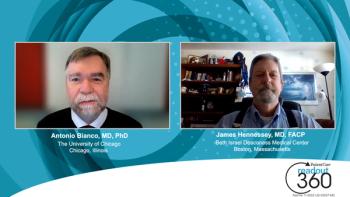
Thyroid Nodules and the Thyroid in Pregnancy: Notes for Primary Care
What groups are at high risk of cancer after diagnosis of thyroid nodules? How does thyroid testing differ by trimester during pregnancy? Short review, here.
The thyroid can come to primary care attention without frank hyper- or hypothyroidism as well as in circumstances distinct from
Here I consider two other “thyroid arenas” that are unrelated but should be included in
Thyroid nodules: indeterminate results are the norm
Approximately 4-7% of the population has thyroid nodules.1 FNA (fine needle aspiration) is the clinical standard for evaluation of thyroid nodules.1 But herein lies the rub: between 10% and 40% of FNAs are indeterminate.3 With 450,000 FNAs performed annually (data for 2012), that leaves considerable uncertainty-for patients and physicians alike. Aggressive treatment without a diagnosis of malignancy is unwarranted. Only 8% to 16% of thyroid nodules are cancerous.1
So, what to do after a thyroid nodule is discovered or when the FNA results are indeterminate?
⺠Identify those persons with nodules who have a higher risk of cancer: persons who have a first degree relative with thyroid cancer or who received radiation as a child or adolescent; those who have had had a prior diagnosis of thyroid cancer; those with a family history of multiple endocrine neoplasia 2 (the syndrome includes medullary thyroid cancer [MTC]), or have an elevated serum calcitonin level (made by MTC cells); those who demonstrate focal uptake of 18F-fluorodeoxy-glucose by the thyroid; and individuals who live in proximity to a nuclear reactor.1 Male gender is also a risk factor.1
⺠Always measure TSH in persons with thyroid nodules.1 A low value may lead to the diagnosis of a hyperactive nodule and subclinical or overt hyperthyroidism.
⺠Molecular analysis has been added to FNA for further diagnostic specificity during thyroid nodule analysis. Approximately 75% of thyroid malignancies have “genetic signatures.”3,4 There are 3 available panels of molecular markers (MMs): Afirma, ThyroSeq v2.1, and ThyGenX/ThyraMir.3,4 The latter 2 MM panels use genetic tools and gene expressions to more clearly define the risk of malignancy in an FNA sample.3 Afirma is a 167-gene expression classifier.4 When Afirma is negative, there is <5% chance of malignancy.4 The latter 2 panels have a negative predictive value similar to Afirma, but an improved positive predictive value.3
The thyroid in pregnancy
Interpretation of thyroid function is unique during pregnancy. For example, elevated estrogen levels in the first trimester increase liver synthesis of thyroid binding globulin (TBG), and at the same time, decrease metabolism of TBG leading to a doubling of serum TBG, T4, and T3.2 Thyroid pathology is also not unusual in gravid women.
Although hyperthyroidism is uncommon in pregnancy, it leads to serious repercussions: spontaneous abortion, premature labor, low birth weight, stillbirth, preeclampsia, and heart failure.5 The incidence of hyperthyroidism during pregnancy is higher in the first trimester and much lower in the third trimester.6 Remain vigilant, however! There is a peak again 7-9 months postpartum.6 Top-line reminders:
⺠The treatment of hyperthyroidism in pregnancy has guidelines. Propylthiouracil is used in the first trimester because methimazole risks birth defects.6 After the first trimester, propylthiouracil has a higher risk of hepatotoxicity and therapy is switched to methimazole.6
⺠Because of the alterations of TBG and thyroid hormones during pregnancy, laboratories offer trimester-specific normal ranges for TSH.7 Do not interpret thyroid function values as low, high, or normal as you would outside of pregnancy!
⺠There are unique etiologies for hyperthyroidism in pregnancy such as human chorionic gonadotropin causing hyperemesis gravidarum (which does not require thyroid-specific treatment).
⺠Radioactive iodine should not be used in pregnancy. It crosses the placenta.6
⺠Painless thyroiditis in the early postpartum period is usually limited and therefore does not affect thyroid function.6 However, it can recur after additional pregnancies and eventually result in hypothyroidism.6
References:
1. Burman KD, Wartofsky L. Thyroid nodules. N. Engl. J. Med. 2015; 373:2347-2356.
2. Yalamanchi S, Cooper DS. Thyroid Disorders in Pregnancy. Curr. Opin. Obstet. Gynecol. 2015;27:406-415.
3. Yu Mon S, Hodak SP. Molecular Diagnostics for Thyroid Nodules. Endocrinol. Metab. Clin. N Am 2014;43:345-365.
4. Smith RB, Ferris RL. Utility of Diagnostic Molecular Markers for Evaluation of Indeterminate Thyroid Nodules. JAMA Otolaryngology-Head and Neck Surgery; published online: March 10, 2016 doi:10.1001/jamaoto.2016.0142.
5. Luewan S, Chakkabut P, Tongsong T. Outcomes of pregnancy complicated by hyperthyroidism. Arch. Gynecol. Obstet. 2011;283:243.
6. De Leo S, Lee SY, Braverman LE. Hyperthyroidism. Lancet. 2016 Mar 30. pii: S0140-6736(16)00278-6. doi: 10.1016/S0140-6736(16)00278-6. [Epub ahead of print]
7. Stricker R, Echenard M, Eberhart R, et al. Evaluation of maternal thyroid function during pregnancy: the importance of using gestational age-specific reference intervals. Eur. J Endocrinol. 2007;157:509.
Newsletter
Enhance your clinical practice with the Patient Care newsletter, offering the latest evidence-based guidelines, diagnostic insights, and treatment strategies for primary care physicians.




















































































































































































































































































